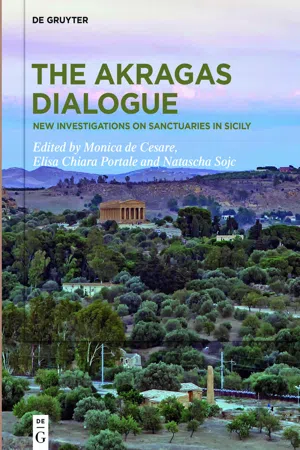
The Akragas Dialogue
New investigations on sanctuaries in Sicily
- 430 pages
- English
- ePUB (mobile friendly)
- Available on iOS & Android
The Akragas Dialogue
New investigations on sanctuaries in Sicily
About this book
The papers of this volume focus on the sacred landscapes of ancient Sicily. Religious and cultural dimensions of Greek sanctuaries are assessed in light of the results of recent exacavations and new readings of literary sources. The material dimension of cult practices in ancient sanctuaries is the central issue of all contributions, with a focus on the findings from ancient Akragas. Great attention is also paid to past ritual activities, which are framed in three complementary areas of enquiry. Firstly, the architectural setting of sanctuaries is examined beyond temple buildings to assess the wider context of their structural and spatial complexity. Secondly, the material culture of votive deposition and religious feasting is analysed in terms of performative characteristics and through the lens of anthropological approaches. Thirdly, the significance of gender in cultic practice is investigated in light of the fresh data retrieved from the field. The new findings presented in this volume contribute to close the existing research gaps in the study of sanctuaries in Sicily, as well as the wider practice of Greek religion.
Frequently asked questions
- Essential is ideal for learners and professionals who enjoy exploring a wide range of subjects. Access the Essential Library with 800,000+ trusted titles and best-sellers across business, personal growth, and the humanities. Includes unlimited reading time and Standard Read Aloud voice.
- Complete: Perfect for advanced learners and researchers needing full, unrestricted access. Unlock 1.4M+ books across hundreds of subjects, including academic and specialized titles. The Complete Plan also includes advanced features like Premium Read Aloud and Research Assistant.
Please note we cannot support devices running on iOS 13 and Android 7 or earlier. Learn more about using the app.
Information
1 Closing in on the Gods. Indirect Communication Between Mortals and Immortals
Abstract
Introduction
Table of contents
- Title Page
- Copyright
- Contents
- Note from the Editors
- Introduction
- 1 Closing in on the Gods. Indirect Communication Between Mortals and Immortals
- 2 Identifier Déméter Thesmophoros et son culte en Sicile à partir des données matérielles
- 3 Dedicants, Offerings, and Sacrifice The Value of the Images
- 4 Introduction to the Study of Sacred Spaces in Ancient Agrigento
- 5 Il santuario di Zeus Olympios ad Agrigento: al di là del tempio monumentale
- 6 Sacelli dimenticati nell’area urbana di Akragas
- 7 Nuove considerazioni sul tempietto tripartito ad Est di Porta V
- 8 Investigating the Terracotta Roofs of Akragas
- 9 The ‘Upper Sanctuary of Demeter’ at S. Biagio in Akragas: A Review
- 10 Le offerte di manufatti bronzei nella pratica votiva agrigentina
- 11 Depositions of Sacrificial Material and Feasting Remains from the Extra-Urban Sanctuary of S. Anna (Agrigento) Appendix: A Note on Characteristic Finds by Linda Adorno
- 12 Sometimes Pigs Fly S. Anna Zooarch Project – Preliminary Results (Seasons 2015–2016)
- 13 Depositional Practices in the Bitalemi Sanctuary in the Archaic Period: Form and Interpretation
- 14 Il santuario di Zeus Meilichios a Selinunte: Dati e materiali inediti per la rilettura del contesto
- 15 I santuari di Demetra Malophoros e Zeus Meilichios a Selinunte: Le nuove indagini
- 16 The New Investigations of the Institute of Fine Arts–NYU in the Main Urban Sanctuary of Selinunte
- 17 New Evidence for Sacred Structures and Ritual Practices in Himera, Piano del Tamburino – Urbanistic Considerations
- 18 A Typology of Votive Offerings: Observations Regarding a Sacred Area on the Piano del Tamburino, Himera
- 19 Rites and Mysteries on the Acropolis of Akrai: Preliminary Remarks on a New Sanctuary Dedicated to the Cult of Demeter and Kore
- Index